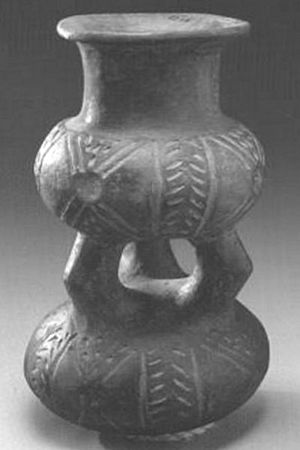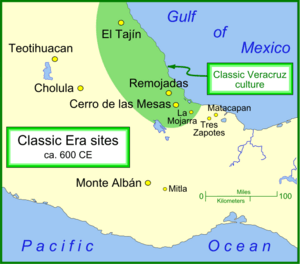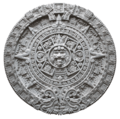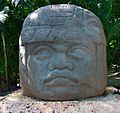Mesoamerican chronology facts for kids

Imagine a time long, long ago, before Europeans came to the Americas. This was the world of pre-Columbian Mesoamerica, a special region in what is now Mexico and Central America. Its history is like a giant puzzle with many different pieces, each representing a different time period. Let's explore how people lived and what amazing things they built, from the very first humans to the time of the Spanish colonization of the Americas.
Contents
A Journey Through Time in Mesoamerica
The Paleo-Indian Period (First Humans)
This was the very beginning! The Paleo-Indian period started when the first people arrived in Mesoamerica. They were mostly hunter-gatherers, meaning they hunted animals and gathered plants for food. They didn't live in one place for long. This period ended around 8,000 BCE, when people started to change their way of life.
The Archaic Era (New Ways of Living)
(Around 8,000 BCE to 2,000 BCE)
During this time, people in Mesoamerica began to learn new skills. They started farming their own food instead of just hunting and gathering. This meant they could stay in one place, so permanent villages began to appear. People also learned to make pottery and even started weaving cloth using a special tool called a loom.
The Preclassic Era (First Great Civilizations)
(Around 2,000 BCE to 200 CE)
This era was a time of big changes! Large groups of people started to form powerful "nation-states." They built the very first huge buildings for ceremonies and created the first real cities. Some of the most famous cultures from this time include the amazing Olmec civilization, the early Zapotec people, the Monte Alto Culture in Guatemala, and the early Maya civilization.
The Classic Era (Golden Age of Cities)
(Around mid-2nd century to early 10th century)
The Classic Era was a golden age for many Mesoamerican cultures. The city of Teotihuacan grew into a massive metropolis, like a giant capital city, and its influence spread across Mesoamerica. This was also when the cities of the Maya people in the southern lowlands, like Tikal, Palenque, and Copán, became very powerful and beautiful.
The Classic Era ended at different times for different places. Teotihuacan fell around the 7th century. However, the Maya cities continued to thrive for many more centuries.
The Postclassic Era (New Powers Rise)
(10th century to 16th century)
Many of the great cities from the Classic Era collapsed during this period. But some places, like those in Oaxaca, Cholula, and the Maya cities in Yucatán (such as Chichen Itza and Uxmal), continued to be important. This time also saw more warfare between different groups.
The Toltec people became very powerful in central Mexico from the 11th to the 13th century, but then their power faded. The northern Maya were united for a while under a city called Mayapan. Then, in the early 15th century, the mighty Aztec Empire began to rise. They were becoming very strong and looked like they might rule the whole region, just like Teotihuacan had done.
But then, everything changed. Spain discovered Mesoamerica, and the Conquistadores arrived to conquer the land. The last independent native state in Mesoamerica, Tayasal, was conquered in 1697.
Images for kids
-
Another amazing Olmec head from La Venta.
-
Temple 2 in Tikal, Guatemala. Imagine climbing those steps!
-
A special pot with a codex-style scene, from the Aztatlan culture of Nayarit. It's now in the LACMA.
-
These are the giant Pillars of Tula in Hidalgo.
See also
 In Spanish: Cronología de Mesoamérica para niños
In Spanish: Cronología de Mesoamérica para niños














